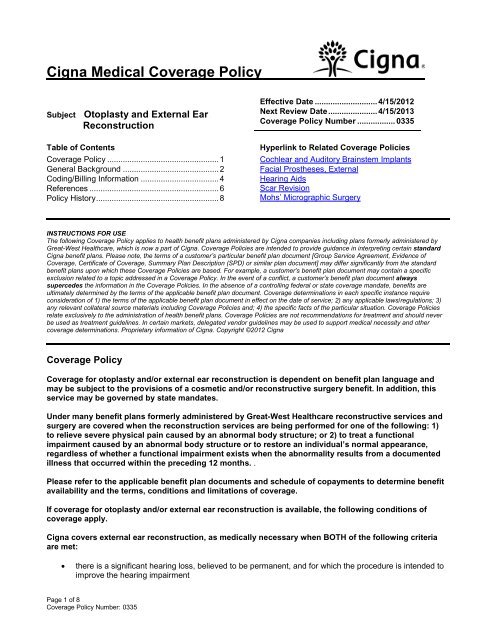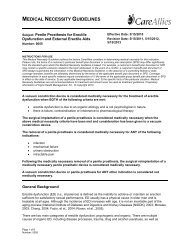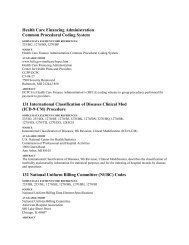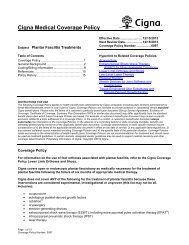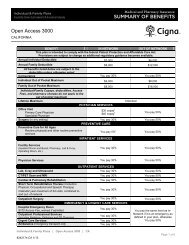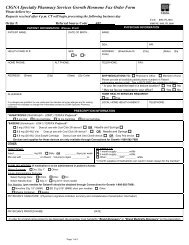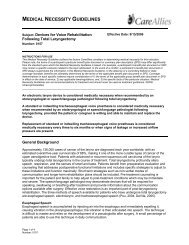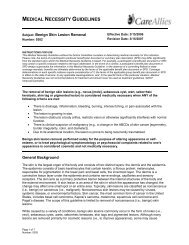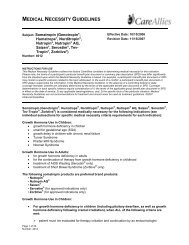Cigna Medical Coverage Policy
Cigna Medical Coverage Policy
Cigna Medical Coverage Policy
You also want an ePaper? Increase the reach of your titles
YUMPU automatically turns print PDFs into web optimized ePapers that Google loves.
<strong>Cigna</strong> <strong>Medical</strong> <strong>Coverage</strong> <strong>Policy</strong><br />
Subject Otoplasty and External Ear<br />
Reconstruction<br />
Table of Contents<br />
<strong>Coverage</strong> <strong>Policy</strong> .................................................. 1<br />
General Background ........................................... 2<br />
Coding/Billing Information ................................... 4<br />
References .......................................................... 6<br />
<strong>Policy</strong> History ....................................................... 8<br />
Page 1 of 8<br />
<strong>Coverage</strong> <strong>Policy</strong> Number: 0335<br />
Effective Date ............................ 4/15/2012<br />
Next Review Date ...................... 4/15/2013<br />
<strong>Coverage</strong> <strong>Policy</strong> Number ................. 0335<br />
Hyperlink to Related <strong>Coverage</strong> Policies<br />
Cochlear and Auditory Brainstem Implants<br />
Facial Prostheses, External<br />
Hearing Aids<br />
Scar Revision<br />
Mohs’ Micrographic Surgery<br />
INSTRUCTIONS FOR USE<br />
The following <strong>Coverage</strong> <strong>Policy</strong> applies to health benefit plans administered by <strong>Cigna</strong> companies including plans formerly administered by<br />
Great-West Healthcare, which is now a part of <strong>Cigna</strong>. <strong>Coverage</strong> Policies are intended to provide guidance in interpreting certain standard<br />
<strong>Cigna</strong> benefit plans. Please note, the terms of a customer’s particular benefit plan document [Group Service Agreement, Evidence of<br />
<strong>Coverage</strong>, Certificate of <strong>Coverage</strong>, Summary Plan Description (SPD) or similar plan document] may differ significantly from the standard<br />
benefit plans upon which these <strong>Coverage</strong> Policies are based. For example, a customer’s benefit plan document may contain a specific<br />
exclusion related to a topic addressed in a <strong>Coverage</strong> <strong>Policy</strong>. In the event of a conflict, a customer’s benefit plan document always<br />
supercedes the information in the <strong>Coverage</strong> Policies. In the absence of a controlling federal or state coverage mandate, benefits are<br />
ultimately determined by the terms of the applicable benefit plan document. <strong>Coverage</strong> determinations in each specific instance require<br />
consideration of 1) the terms of the applicable benefit plan document in effect on the date of service; 2) any applicable laws/regulations; 3)<br />
any relevant collateral source materials including <strong>Coverage</strong> Policies and; 4) the specific facts of the particular situation. <strong>Coverage</strong> Policies<br />
relate exclusively to the administration of health benefit plans. <strong>Coverage</strong> Policies are not recommendations for treatment and should never<br />
be used as treatment guidelines. In certain markets, delegated vendor guidelines may be used to support medical necessity and other<br />
coverage determinations. Proprietary information of <strong>Cigna</strong>. Copyright ©2012 <strong>Cigna</strong><br />
<strong>Coverage</strong> <strong>Policy</strong><br />
<strong>Coverage</strong> for otoplasty and/or external ear reconstruction is dependent on benefit plan language and<br />
may be subject to the provisions of a cosmetic and/or reconstructive surgery benefit. In addition, this<br />
service may be governed by state mandates.<br />
Under many benefit plans formerly administered by Great-West Healthcare reconstructive services and<br />
surgery are covered when the reconstruction services are being performed for one of the following: 1)<br />
to relieve severe physical pain caused by an abnormal body structure; or 2) to treat a functional<br />
impairment caused by an abnormal body structure or to restore an individual’s normal appearance,<br />
regardless of whether a functional impairment exists when the abnormality results from a documented<br />
illness that occurred within the preceding 12 months. .<br />
Please refer to the applicable benefit plan documents and schedule of copayments to determine benefit<br />
availability and the terms, conditions and limitations of coverage.<br />
If coverage for otoplasty and/or external ear reconstruction is available, the following conditions of<br />
coverage apply.<br />
<strong>Cigna</strong> covers external ear reconstruction, as medically necessary when BOTH of the following criteria<br />
are met:<br />
• there is a significant hearing loss, believed to be permanent, and for which the procedure is intended to<br />
improve the hearing impairment
• EITHER of the following indications:<br />
� correction of an external ear deformity associated with an abnormality of the external auditory canal<br />
(e.g., stenosis)<br />
� as part of a staged reconstruction for an absent or inadequate external ear, when the reconstruction<br />
involves placement of a hearing aid or cochlear implant, and external ear reconstruction is required<br />
for proper functioning of the device<br />
<strong>Cigna</strong> does not cover external ear reconstruction in the absence of a hearing impairment or when<br />
performed solely to improve physical appearance because it is considered cosmetic in nature and not<br />
medically necessary.<br />
<strong>Cigna</strong> does not cover otoplasty (CPT ® code 69300) for any indication, including the following, because it<br />
is considered cosmetic in nature and not medically necessary (this list may not be all-inclusive):<br />
• prominent/protruding ears<br />
• lop ears<br />
• cupped ears<br />
• constricted ears<br />
General Background<br />
External ear reconstruction is a procedure that attempts to reconstruct the external ear to normal anatomical<br />
shape and appearance. Reconstruction involves various degrees of surgical repair and may be performed to<br />
correct the congenital absence of an external ear for conditions such as microtia and anotia or to correct an<br />
external ear that has been altered as a result of trauma or surgery. External ear deformities usually do not result<br />
in a functional deficit. External ear deformities that do not result in significant functional hearing impairment (i.e.,<br />
inability to hear normal conversation) do not require any intervention; treatment would be considered cosmetic in<br />
nature and not medically necessary.<br />
Otoplasty, a procedure to correct protruding ears, is generally performed solely for cosmetic purposes; to<br />
improve the appearance ears.<br />
Congenital Abnormalities<br />
Prominent/Protruding Ears: Prominent ears are a congenital abnormality in which the ears tend to project<br />
excessively from the skull. This condition may occur as a result of an inadequately formed antihelix (i.e., the<br />
outer frame of the auricle), an overdeveloped or excessively deep concha (i.e., hollow portion of the outer ear),<br />
or a combination of these conditions (American Society of Plastic Surgeons [ASPS], 2005). Normal prominence<br />
is defined as 1.2–2.0 cm from the post-auricular scalp to the lateral aspect of the superior helix. Ear prominence<br />
is typically defined as a protrusion of the helix 2 cm or more from the postauricular scalp. Otoplasty performed to<br />
correct prominent ears involves recreating an antihelical fold and possibly insetting or resecting the concha to<br />
decrease the prominence. The primary goal of surgical correction for prominent/protruding ears is improvement<br />
of physical appearance (i.e., cosmesis).<br />
Microtia: Microtia describes an incompletely formed ear and is commonly associated with congenital aural<br />
atresia (Murakami and Quatela, 2005; Kelly and Scholes, 2007). It may occur as a single disorder, as a feature<br />
of hemifacial microsomia complex (i.e., one side of the face does not grow in proportion to the other side), or as<br />
part of a congenital syndrome, such as Treacher Collin’s syndrome. While there is no universally accepted<br />
classification system for microtia, a system that assigns grades based on the severity of the deformity has been<br />
adopted (Zim, 2003; Murakami and Quatela, 2005). Microtia may be divided into the following categories:<br />
Type I A mildly deformed ear that typically has a slightly dysmorphic helix and antihelix. The<br />
external auditory meatus is usually present.<br />
Type II Ears that have all major structures present to some degree, but with an absolute deficiency<br />
of tissue; surgical correction requires the addition of cartilage and skin; the external<br />
Page 2 of 8<br />
<strong>Coverage</strong> <strong>Policy</strong> Number: 0335
auditory meatus is present but may demonstrate some degree of deformity. The auricle is<br />
usually hook-, S- or question-mark shaped in appearance.<br />
Type III Few or no recognizable landmarks of the auricle or canal although the lobule is usually<br />
present and positioned anteriorly.<br />
Microtia may result in subtle abnormalities of the size, shape and location of the pinna and ear canal, or it may<br />
occur as a major deformity, with small remnants of skin and cartilage, as well as absence of the ear canal<br />
opening. Mild ear deformities are associated with altered physical appearance and are usually not associated<br />
with a functional deficit. Deformities that may be considered Type I deformities include mildly constricted ears,<br />
lop-ear deformities (characterized by an absence of the antihelical fold causing the ear to fall forward) and<br />
cupped-ear deformities (excessive cartilage of the ear canal causing the ear to project outward). With these<br />
deformities, all major structures are present to some degree.<br />
Type II deformities may include miniear and severe cup deformities. The external auditory meatus is present,<br />
although it may demonstrate some degree of stenosis.<br />
Anotia is the complete absence of the external ear and auditory canal and may be considered Type III microtia,<br />
although a few sources consider this a fourth degree of severity.<br />
The inner ear function of the affected ear usually remains adequate, resulting in some ability to hear on the<br />
affected side (Bonilla, 2009) and the contralateral ear is usually normal, allowing for normal development of<br />
speech. However, sensorineural, conductive, or mixed hearing loss may be present in the microtia patient<br />
(Beahm, Walton, 2002; Kelly, Scholes, 2007) and it has been reported that hearing impairment may be reduced<br />
by approximately 40% on the affected side. Congenital deformities of the ear may be coupled with abnormalities<br />
involving the external ear canal (EAC) and tympanic membrane; consequently, these abnormalities may affect<br />
sound conduction. Microtia has also been associated with middle ear abnormalities; patients with complete or<br />
partial stenosis of the EAC commonly have severe ossicular malformations (Kim, et al., 2002).<br />
Ear reconstruction may be performed to improve physical appearance for patients with microtia, although, when<br />
considering surgery, emphasis is also placed on restoring sufficient hearing to allow normal speech<br />
development. Other operations, such as canal or middle ear reconstruction, may be performed to improve<br />
patient outcomes. Surgery performed to improve hearing is recommended if there are bilateral deformities<br />
resulting in conductive hearing loss (Haddad, 2004) or for unilateral microtia with impaired hearing of the normal<br />
ear (Medicare Services Advisory Committee [MSAC], 2000). In patients with bilateral microtia, bone conduction<br />
hearing aids are often recommended (Murakami, Quatela, 2005; Kelly, Scholes, 2007). Hearing amplification is<br />
not usually required for unilateral atresia, although binaural hearing is superior to monaural in terms of sound<br />
localization and speech perception.<br />
Although it may be performed on adults, it is generally recommended that external ear reconstruction for<br />
treatment of ear deformities, more specifically microtia, be performed when the patient is between ages six and<br />
eight. By this age, the ear has reached 85–90% of its adult size. In addition, at this time, the patient's rib size is<br />
sufficient to allow a rib graft. Early surgery may also result in the avoidance of social problems for the child. In<br />
cases of bilateral microtia, reconstructions may begin as early as age four.<br />
Trauma/Neoplasm<br />
Trauma to the ear may result from burn injuries, human or animal bites, falls or motor vehicle accidents. The<br />
unavoidable exposure to sun of the helical rim of the ear contributes to the development of skin neoplasm and<br />
removal with precise margin control is recommended. Despite efforts to preserve healthy tissue in the presence<br />
of tissue injury or neoplasm, reconstruction is often necessary to improve physical appearance and function. For<br />
some patients, auricular prostheses may be considered an alternative to ear reconstruction. Nonetheless,<br />
reconstruction to improve physical appearance in the absence of improving function is considered cosmetic.<br />
Cochlear Implant<br />
Sensorineural hearing loss may occur as a result of congenital defects, disease or trauma of the inner ear, and<br />
can cause significant hearing impairment. When the hearing loss becomes profound and a hearing aid is<br />
ineffective, a cochlear implant may maximize hearing ability for patients.<br />
Cochlear implants have two integral components:<br />
Page 3 of 8<br />
<strong>Coverage</strong> <strong>Policy</strong> Number: 0335
• The internal component consists of a receiver-stimulator connected to an infracochlear electrode array<br />
made up of electrode rings that are integrated into a silicone carrier. The stimulator is implanted in the<br />
skull near the cochlea and is connected to the electrode array via a lead wire.<br />
• The external component consists of a microphone worn on the external ear, a speech processor worn at<br />
ear-level or on the body, and a transmitter worn behind the ear.<br />
Although considered rare, sensorineural hearing loss may occur with congenital ear anomalies such as aural<br />
atresia and microtia. Aural atresia is a congenital defect characterized by malformations of the external and<br />
middle ear structures. Consequently, otoplasty may be considered as part of the reconstructive process and<br />
implantation of a cochlear device. Cochlear microphone placement may be difficult in some cases and external<br />
ear reconstruction may be required to facilitate use of the device.<br />
Treatment<br />
Minor deformities in ear shape may be overcome by early splinting or taping of a newborn child’s ear (Burns,<br />
Blackwell, 2004). Nonsurgical treatment of microtia, involving a prosthetic device, is an alternative to surgical<br />
correction. Bone-anchored hearing aid devices are often used to improve conductive hearing loss for cases of<br />
bilateral microtia involving hearing impairment.<br />
Surgical repair is generally performed for cosmetic purposes and in some rare situations, functional reasons.<br />
The overall goal is to reconstruct an ear that is normal in appearance and function. For some cases an incision<br />
is made behind the ear to reduce one or more components, for other more extensive cases reconstruction may<br />
involve cartilage reshaping and sculpturing. The reconstruction surgery for severe cases typically involves<br />
multiple stages that are performed at least three to six months apart. The initial stages involve the removal of<br />
scarred, deformed tissue and the implantation of costal cartilage (e.g., rib cartilage grafting); additional stages<br />
are performed for lobule transfer, postauricular skin grafting and tragus reconstruction (Murakami, Quatela,<br />
2005). Although numerous implants are available for surgical reconstruction of the ear, the gold standard of<br />
therapy for treating microtia deformities is autologous rib cartilage grafting. In cases where there is associated<br />
aural atresia or decreased hearing in the contralateral normal ear, a separate surgery is indicated to restore<br />
hearing function.<br />
Complications associated with otoplasty and/or external ear reconstructive procedures include bleeding,<br />
infection and possibly pneumothorax if a rib graft is used. Complications associated with middle ear surgery for<br />
improvement of hearing include restenosis of the external auditory canal and damage to the facial nerve<br />
(Bonilla, 2009).<br />
Professional Societies/Organizations<br />
Guidelines and/or position statements from the American Academy of Pediatrics do not comment on the<br />
performance of otoplasty for treatment of external ear deformities. According to the American Society of Plastic<br />
Surgeons (ASPS), otoplasty is considered a reconstructive surgery that may be performed in children or adults,<br />
although the procedure is more common in children (ASPS, 2005).<br />
Summary<br />
Otoplasty, correction of protruding ears, is frequently performed to improve physical appearance. When the<br />
procedure is performed solely to improve physical appearance, treatment is considered cosmetic.<br />
For severe ear deformities there may be associated loss of hearing, requiring surgical reconstructive procedures<br />
to correct the functional deficit. The published, peer-reviewed scientific literature provides evidence to support<br />
that when performed in cases involving canal malformation, external ear reconstruction in combination with<br />
auricular reconstruction and atresia repair, can be effective in improving hearing impairment for selected cases.<br />
Although rare, external ear reconstruction may also be considered medically necessary when performed as part<br />
of a reconstructive process involving cochlear implantation if difficulties arise with cochlear microphone<br />
placement.<br />
Coding/Billing Information<br />
Note: This list of codes may not be all-inclusive.<br />
Page 4 of 8<br />
<strong>Coverage</strong> <strong>Policy</strong> Number: 0335
External Ear Reconstruction<br />
Covered when medically necessary as outlined in this policy:<br />
CPT ® *<br />
Codes<br />
Description<br />
69310 Reconstruction of external auditory canal (meatoplasty) (eg, for stenosis due to<br />
injury, infection) (separate procedure)<br />
69320 Reconstruction external auditory canal for congenital atresia, single stage<br />
69399 Unlisted procedure, external ear<br />
ICD-9-CM<br />
Diagnosis<br />
Codes<br />
Description<br />
744.00 Unspecified anomaly of ear with impairment of hearing<br />
744.01 Anomalies of ear causing impairment of hearing; absence of external ear<br />
744.02 Anomalies of ear causing impairment of hearing ; other anomalies of external ear<br />
with impairment of hearing<br />
744.09 Anomalies of ear causing impairment of hearing, other; absence of ear,<br />
congenital<br />
744.23 Microtia<br />
Cosmetic/Not <strong>Medical</strong>ly Necessary/Not covered:<br />
CPT ® *<br />
Codes<br />
Description<br />
69310 Reconstruction of external auditory canal (meatoplasty) (eg, for stenosis due to<br />
injury, infection) (separate procedure)<br />
69320 Reconstruction external auditory canal for congenital atresia, single stage<br />
69399 Unlisted procedure, external ear<br />
ICD-9-CM<br />
Diagnosis<br />
Codes<br />
Description<br />
744.21 Congenital absence of ear lobe<br />
744.22 Macrotia<br />
744.29 Other congenital anomaly of ear; Bat ear, prominence of auricle, Darwin’s<br />
tubercle, pointed ear, ridge ear<br />
744.3 Unspecified anomaly of ear<br />
Otoplasty<br />
Cosmetic/Not <strong>Medical</strong>ly Necessary/Not covered:<br />
CPT ® *<br />
Codes<br />
Description<br />
69300 Otoplasty, protruding ear, with or without size reduction<br />
ICD-9-CM<br />
Diagnosis<br />
Codes<br />
Description<br />
All codes<br />
*Current Procedural Terminology (CPT ® ) © 2011 American <strong>Medical</strong> Association: Chicago, IL.<br />
Page 5 of 8<br />
<strong>Coverage</strong> <strong>Policy</strong> Number: 0335
References<br />
1. Adamson PA, Doud Galli SK. Otoplasty. Cummings CW, Flint PW, Haughey BH, Robbins KT, Thomas<br />
JR, Harker LA, et al. editors. In: Otolaryngology: Head and Neck Surgery, 4 th ed., Ch 36, Otoplasty.<br />
Copyright © 2005 Mosby, Inc.<br />
2. Adamson PA, Litner JA. Otoplasty technique. Otolaryngol Clin North Am. 2007 Apr;40(2):305-18.<br />
3. American Society of Plastic Surgeons (ASPS). Ear deformity: prominent ears: recommended criteria for<br />
third-party payer coverage [position paper]. Socioeconomic Subcommittee. Approved by ASPS Board of<br />
December 2005. Accessed February 14, 2012. Available at URL address:<br />
http://www.plasticsurgery.org/Documents/<strong>Medical</strong>_Profesionals/Otoplasty2.pdf<br />
4. Beahm EK, Walton RL. Auricular reconstruction for microtia: Part I: anatomy, embryology, and clinical<br />
evaluation. Plast Reconstr Surg. 2002 Jun:109(7):2473-82.<br />
5. Bonilla JA. Microtia. In: eMedicine specialties > pediatrics > otolaryngology. Updated June 26, 2009.<br />
Accessed February 14, 2011. Available at URL address: http://www.emedicine.com/ped/topic3003.htm<br />
6. Brent B. Reconstructive ear surgery. Microtia, Auricular Reconstruction. Copyright © 1998-2011.<br />
Accessed February 14, 2012. Available at URL address: http://www.earsurgery.com/index.html<br />
7. Brent B. Technical advances in ear reconstruction with autogenous rib cartilage grafts: personal<br />
experience with 1200 cases. Plast Reconstr Surg. 1999 Aug;104(2):319-34.<br />
8. Brodland DG. Auricular reconstruction. Dermatol Clin. 2005 Jan;23(1):23-14, v.<br />
9. Burns JL, Blackwell SJ. Anotia. In: Townsend CM Jr, Beauchamp RD, Evers BM, Mattox KL, editors.<br />
Sabiston textbook of surgery. 17 th ed. Philadelphia, PA: Saunders; 2004. Chapter 72: plastic surgery. p.<br />
2189.<br />
10. Ear Plastic Surgery. American Academy of Otolaryngology—Head and Neck Surgery (AAO-HNS). ENT<br />
link > ENT health information > ears. © Copyright 2011 American Academy of Otolaryngology — Head<br />
and Neck Surgery. Updated 7/2011. Accessed February 14, 2012. Available at URL address:<br />
http://www.entnet.org/HealthInformation/earPlasticSurgery.cfm<br />
11. FACES: The National Craniofacial Association. Last updated October 3, 2011. Accessed February 14,<br />
2012. Available at URL address: http://www.faces-cranio.org/<br />
12. Fearon J. A guide to understanding microtia. Dallas, TX: Children’s Craniofacial Association (CCA);<br />
1993. Originally published 1993 Jun. Accessed February 14, 2012. Available at URL address:<br />
http://www.ccakids.com/synBook.asp<br />
13. Gosain AK, Kumar A, Huang G. Prominent ears in children younger than 4 years of age: what is the<br />
appropriate timing for otoplasty? Plast Reconstr Surg. 2004 Oct;114(5):1042-54.<br />
14. Haddad J. Congenital malformations. In: Behrman RE, Kleigman RM, Jenson HB, editors. Nelson<br />
textbook of pediatrics. 17 th ed. Philadelphia, PA: Saunders; 2004. Chapter 628. p. 2135.<br />
15. Kelley P, Hollier L, Stal S. Otoplasty: evaluation, technique, and review. J Craniofac Surg. 2003<br />
Sep;14(5):643-53.<br />
16. Kelley PE, Scholes MA. Microtia and congenital aural atresia. Otolaryngol Clin North Am. 2007<br />
Feb;40(1):61-80, vi.<br />
Page 6 of 8<br />
<strong>Coverage</strong> <strong>Policy</strong> Number: 0335
17. Kim SY, Bothwell NE, Backous DD. The expanding role of the otolaryngologist in managing infants and<br />
children with hearing loss. Otolaryngol Clin North Am. 2002 Aug;35(4):699-710.<br />
18. Leach, LL Jr, Biavati MJ. Ear reconstruction. In: eMedicine specialties > otolaryngology and facial<br />
plastic surgery > reconstructive surgery. Updated Dec 15, 2011. Accessed February 14, 2012.<br />
Available at URL address: http://www.emedicine.com/ent/topic79.htm<br />
19. Lin K, Marrinan MS, Shapiro WH, Kenna MA, Cohen NL. Combined microtia and aural atresia: issues in<br />
cochlear implantation. Laryngoscope. 2005 Jan;115(1):39-43.<br />
20. McKinnon BJ, Jahrsdoerfer RA. Congenital auricular atresia: update on options for intervention and<br />
timing of repair. Otolaryngol Clin North Am. 2002 Aug;35(4):877-90.<br />
21. Medicare Services Advisory Committee (MSAC); Doust J, Murray A-M, Vandervord J. Total ear<br />
reconstruction: MSAC application 1024 [assessment report]. Canberra, Australia: Commonwealth of<br />
Australia; 2000 Mar. Endorsed 2000 March 6 by the Commonwealth Minister for Health and Aged Care.<br />
Accessed February 14, 2012. Available at URL address:<br />
http://www.msac.gov.au/internet/msac/publishing.nsf/Content/MSAC%20Completed%20Assessments%<br />
201021%20-%201040<br />
22. Murakami CS, Quatela VC. Reconstruction surgery of the ear: Microtia Reconstruction. In: Cummings<br />
CW, Flint PW, Haughey BH, Robbins KT, Thomas TR, Harker LA, et al., editors. Otolaryngology: Head<br />
and Neck Surgery. 4 th ed. Copyright © 2005. Chapter 199a.<br />
23. Owsley TG. Otoplastic surgery for the protruding ear [Abstract]. Atlas Oral Maxillofac Surg Clin North<br />
Am. 2004 Mar;12(1):131-9.<br />
24. Renner G, Lane RV. Auricular reconstruction: an update. Curr Opin Otolaryngol Head Neck Surg. 2004<br />
Aug;12(4):277-80.<br />
25. Types of hearing loss. American Speech-Language-Hearing Association. For the public > hearing and<br />
balance > disorders and diseases. © 1997- 2012 American Speech-Language-Hearing Association.<br />
Accessed February 14, 2012. Available at URL address:<br />
http://www.asha.org/public/hearing/disorders/types.htm<br />
26. Wood RJ, Jurkiewicz MJ. Ear reconstruction. In: Schwartz SI, G. Shires GT, Spencer FC, Daly JM,<br />
Fischer JE, Galloway AC, editors. Principles of surgery. New York, NY: McGraw-Hill Companies, Inc.;<br />
1999. Chapter 43: plastic and reconstructive surgery.<br />
27. Zim SA. Microtia reconstruction: an update [review]. Curr Opin Otolaryngol Head Neck Surg. 2003<br />
Aug;11(4):275-81.<br />
Page 7 of 8<br />
<strong>Coverage</strong> <strong>Policy</strong> Number: 0335
<strong>Policy</strong> History<br />
Pre-Merger Last Review <strong>Policy</strong> Title<br />
Organizations Date Number<br />
<strong>Cigna</strong> HealthCare 4/15/2010 0335 Otoplasty/External Ear<br />
Reconstruction<br />
Great-West Healthcare 4/15/2010 95.237.06 Otoplasty<br />
The registered marks "<strong>Cigna</strong>" and "<strong>Cigna</strong> HealthCare" as well as the "Tree of Life" logo are owned by <strong>Cigna</strong> Intellectual Property, Inc., licensed<br />
for use by <strong>Cigna</strong> Corporation and its operating subsidiaries. All products and services are provided by or through such operating subsidiaries<br />
and not by <strong>Cigna</strong> Corporation. Such operating subsidiaries include Connecticut General Life Insurance Company, <strong>Cigna</strong> Health and Life<br />
Insurance Company, <strong>Cigna</strong> Behavioral Health, Inc., <strong>Cigna</strong> Health Management, Inc., and HMO or service company subsidiaries of <strong>Cigna</strong> Health<br />
Corporation and <strong>Cigna</strong> Dental Health, Inc. In Arizona, HMO plans are offered by <strong>Cigna</strong> HealthCare of Arizona, Inc. In California, HMO plans are<br />
offered by <strong>Cigna</strong> HealthCare of California, Inc. In Connecticut, HMO plans are offered by <strong>Cigna</strong> HealthCare of Connecticut, Inc. In North<br />
Carolina, HMO plans are offered by <strong>Cigna</strong> HealthCare of North Carolina, Inc. In Virginia, HMO plans are offered by <strong>Cigna</strong> HealthCare Mid-<br />
Atlantic, Inc. All other medical plans in these states are insured or administered by Connecticut General Life Insurance Company or <strong>Cigna</strong> Health<br />
and Life Insurance Company.<br />
Page 8 of 8<br />
<strong>Coverage</strong> <strong>Policy</strong> Number: 0335


